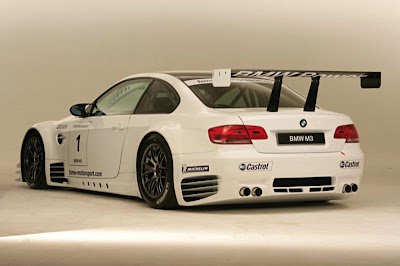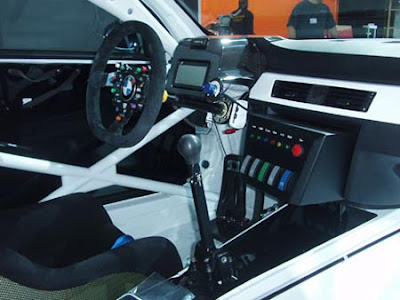Wednesday, June 30, 2010
 2010 335d
2010 335d
The 2010 335d will erase those bad memories forever - if you'll give it 5.9 seconds of your time. That's how long it will take for the twin-turbo'd, direct-injected 3 liter diesel six to get you to 60 mph. This powerhouse makes 265 hp and an astounding 425 lbs.-ft of torque - output comparable to a large displacement V-8, but without the big V-8's appetite for fuel.
At 80 mph, the engine is barely idling at 2,000 RPM. At 120, it is just beginning to stretch its legs.
A gas-burning 335i is slightly quicker to 60 and about as fast, all out - but you'll be stopping more often given its SUV-like 17 MPG city and 26 MPG highway.
The diesel is electric motor quiet on the highway and almost impossible to distinguish from a gas engine at idle. It even behaves like a gas engine - a big V-8 gas engine - with an RPM range that runs to 5,000-plus RPM (high for a diesel they typically max out around 4,000-4,500 RPM) and muscle car-like off-the-line acceleration and part-throttle passing power.
Some say you can't have your cake and eat it, too. They were wrong!
Labels: BMW

Sportec has released the images and details of the new 2010 Sportec SPR1R Porsche 911 which will be premiered at the Salon Prive 2010.
The Sportec Porsche 911 SPR1R comes with titanium connection rods, a flat carbon fibre under floor, active suspension and F1 style ceramic brake discs as well as composite (carbon / Kevlar) body panels, forged alloy wheels and an integrated safety cage.
The new Sportec SPR1R makes the 0 to 60 mph sprint in 3 seconds and top speed remains at 236 mph. The SPR1R also comes with a driver adjustable traction control system, managed via a touch screen mounted in the center console. This unit also doubles as a vehicle data logger and lap timer, which also allows owners to monitor key engine data in real time.
Dubbed the SPR1R, the car features composite (carbon / Kevlar) body panels, a flat carbon fiber under floor, an active suspension, carbon ceramic brakes, and a roll cage. While this is all standard on the SPR1 M, the SPR1R weighs 50 kilograms (110 pounds) less and has an adjustable traction control system (which doubles as a data logger and lap timer).
As for the styling, SPR1R comes with lightweight 20 inch forged alloy wheels and a carbon fibre rear wing, while the interior is covered in leather and alcantara.
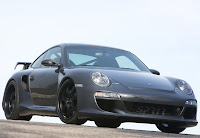

Press Release
SPORTEC RETURNS TO SALON PRIVÉ EVENT WITH IMPROVED SPR1R SUPERCAR
Having stunned the motoring press and Salon Privé show goers last year with the UK premier of the SPR1, SPORTEC is set to debut a new, faster, lighter and improved version of the Swiss built supercar at this year's event - the SPR1R.
Conceived, designed and constructed in Switzerland by SPORTEC's technical team, the new version of the SPR1 offers unrivalled supercar performance and exclusivity, carrying over the 858PS bi-turbo, 3.6-litre, 24-valve, flat six T80M engine and permanent four wheel drive of the previous version.
Likewise the SPORTEC SPR1R's specification includes the titanium connecting rods, a flat carbon fibre under floor, active suspension and F1 style ceramic brake discs of other SPR1 models, while the use of composite (carbon / Kevlar) body panels, forged alloy wheels, an integrated safety cage and ceramic brake discs allows the SPR1 to be lighter, safer and more dynamic than other cars in its class.
For 2010, the SPR1R boasts a number of detail improvements. Firstly, by concentrating on weight reduction across a variety of key components, SPORTEC's technicians have managed to reduce the weight of the SPR1R by 50 kilograms, to a total of 1295 kilos.
This development makes the SPR1R one of the lightest supercars on the market (a Bugatti Veyron weighs 1990 kilos for comparison) and enhances the SPR1R's power to weight ratio to a staggering 655 bhp per ton.
In addition, SPORTEC has added a driver adjustable traction control system, managed via a touch screen mounted in the centre console. This unit also doubles as a vehicle data logger and lap timer, which also allows owners to monitor key engine data in real time.
These combined improvements have yielded considerable performance benefits. While the 0-62mph (100kmh) time is unchanged at 3.0 seconds, the 300 kmh (186mph) increment arrives 0.9 seconds quicker than previously, highlighting the effectiveness of the changes. The quoted top speed of more than 236mph remains unaltered
Available in a choice of colours, the SPR1R boasts a number of exclusive SPORTEC styling and interior touches, including lightweight 20 inch forged alloy wheels, a carbon fibre rear wing and leather / alcantara interior.
Subtle, exclusive yet very useable and designed to deliver unrivalled performance, the 2010 SPR1R is designed to stay ahead of the supercar competition.
APS of Brackley is the UK concession for SPORTEC, and APS / SPORTEC is delighted that the 2010 SPR1R will be making its British debut at the prestigious Salon Privé show at London's Hurlingham club, between 21st-23rd July.
2010 MY SPORTEC SPR1R Technical Data
Engine type Six cylinder boxer engine
Displacement 3600cc
Bore/stroke 100 x 76.4mm
Compression ratio 9.0:1
Power output 858PS @ 8200rpm
Torque output 642lb.ft @ 4800rpm
Engine management Bosch ME 7.8 SPORTEC MFC G4.0
Fuel quality 98 RON unleaded
Idle speed 820rpm
Max engine speed 1st gear 8700rpm
2nd-5th gear 8500rpm
6th gear 8200rpm
Emissions standard Euro IV
Transmission
Six-speed manual, four wheel drive
Gear ratios:
1st 3.82
2nd 2.05
3rd 1.41
4th 1.12
5th 0.92
6th 0.75
Reverse gear 2.86
Final drive ratio 3.44
Speed at 1000rpm in 6th gear 30.76mph
Clutch disc diameter 240mm
Chassis
Front axle Light alloy links with McPherson struts, uniball top mounts
Rear axle Multi link suspension, uniball top mounts
Steering Electric power steering
Steering ratio 1:16.9
Steering from lock to lock 2.98
Brakes Front: 8 piston light alloy calliper
Rear: 4 piston light alloy calliper
Brake discs Front: Cross drilled and ventilated ceramic 380 x 34mm discs
Rear: Cross drilled and ventilated ceramic 322 x 28mm discs
Wheels Front: 9J x 20 inch 30mm offset
Rear: 12.5J x 20 inch 40mm offset
Tyres Front: 255/30 R20 92Y XL
Rear: 345/25 R20 100Y
Weights
Kerb weight (DIN)* 1295 KG
Front / rear weight distribution 40/60
*Depending on equipment
Dimensions
Length 4467mm
Width 1878mm
Height 1275mm
Wheelbase 2350mm
Track front: 1550mm
Rear: 1564mm
Fuel capacity 64 litres
Performance
Maximum speed Over 236mph (380kmh)
Acceleration:
0-100kmh (62 mph) 3.0 seconds
0-200kmh (124mph) 8.6 seconds
0-300kmh (186mph) 18.9 seconds
Power to weight ratio 655 bhp per ton
Bhp per litre 238

Pogea Racing has released an incredible upgrade package for the special edition Fiat 500 Abarth 595 Ferrari that includes both performance and styling enhancements.
Pogea Racing believes the standard 180 hp of the special edition model is not enough, so they gave it another 100 hp. This means the total output of the Pogea Fiat 500 Ferrari gets up to 268PS and 330 Nm of torque. In a car this size, with front-wheel-drive, getting so close to 300 hp is pure madness.
The standard Fiat 500 Ferrari Dealers Edition makes a respectable 164-hp and 170 lb-ft of torque. Pogea Racing decided to take it a step further and added larger stainless steel exhaust system, modified downpipe, and a new catalytic converter. All those modifications allow for a total of 264-hp and a maximum torque of 243 lb-ft. For stopping power Pogea Racing upgraded the OEM brakes with their 4-piston brake assembly.
To add cooling to both the intake air, and to lower the combustion temperature, a modified Intake cooling system was created. A center-mount, larger, more efficient intercooler replaces the two smaller original intercoolers. Additional air is being pumped into the engine compartment to cool the accessories via the carbon fiber parts of the Assetto Corse. Fuel injection is optimized by changing fuel pressure valves and using upgraded Bosch fuel injectors.
With the added power comes upgraded four-piston caliper brakes. Options available include an upgrade suspension, unspecified carbon fiber parts, and leather upholstery. Taking a cue from the Ferrari 430 Scuderia, the car appears to be painted in the same Scuderia Red with grey race stripes around the venting on the hood. Pricing on the Pogea Racing 500 package begins at €3400.








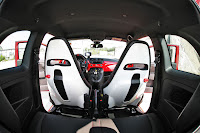
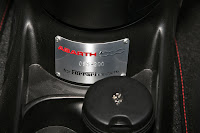


Press Release
The mighty Italian - Fiat 500 FERRARI DEALERS EDITION with 268 PS
When there is a new project at Pogea Racing, one can be absolutely sure that everything is well studied to the smallest detail.
The hardest part of the development process was to avoid using a separate Tuning Box Unit. Unlike other "tuners", Pogea Racing starts with the OEM ECU of the Fiat 500 Abarth, instead of relying on a separate controller unit. Pogea Racing develops the software data to work directly with the vehicle's ECU. This assures that instructions that are sent from the ECU direct all normal functions of the car properly. An auxiliary unit cannot control all functions, and will ignore the vehicle's ECU's commands. Herein lies the principal difference between Pogea Racing's development and other Tuners.
Pogea Racing chose a very rare model, the Fiat 500 FERRARI DEALERS EDITION of Abarth. The standard engine is already relatively strong, coming with 165PS and 230Nm. Pogea Racing increases the performance of the small Italian model by adding 100hp on top of the standard engine, producing 268PS and 330 Nm total power. The Pogea Racing model was also measured and developed on one of the most modern all-wheel drive dynamometers. To get this power out of the mighty Italian car, they changed the exhaust system and replaced it with a larger stainless steel exhaust system, modified downpipe, and a new catalytic converter. The tailpipes can be chosen by the customer from many available Designs.
Power comes from the new hybrid turbocharger from Pogea Racing. Currently, there are two turbocharger variants that the customer can choose from. To add cooling to both the intake air, and to lower the combustion temperature, a modified Intake cooling system was created. A center-mount, larger, more efficient intercooler replaces the two smaller original intercoolers. Additional air is being pumped into the engine compartment to cool the accessories via the carbon fiber parts of the Assetto Corse. Fuel injection is optimized by changing fuel pressure valves and using upgraded Bosch fuel injectors.
For increased stopping power Pogea Racing upgraded the OEM Brake system with their 4-piston brake assembly. This detail is very important to Pogea Racing, and they developed a brake system with identical weight to the OEM brake system, but about 1,8m reduced braking distance when compared to the OEM brakes. You can round up the entire kit with TÜV Approval and with an optional warranty for engine, turbo, and transmission. Pogea Racing completes its tuning work exclusively at their headquarters in the center at the Bodensee.
Apart from the performance cure Pogea Racing also offers Assetto Corse Parts as legal TÜV Approved Parts dealer in Germany for the current models. The parts come directly from the factory in Italy. So now your Fiat can become optically at least a large Ferraristi, or even an image of the 100 PS Assetto Corse. Pogea Racing has other services; leather work, individual suspension systems, and carbon fiber parts can also be part of your individualization. Now there is one tuning company which makes just about everything for your little Italian. Prices for the smallest Change begin at 3400€.
Hyundai began taking orders on the 21st June and has since gained remarkable popularity for the newest addition to its line-up. The new Avante made its public debut at the Busan International Motor Show in April.
For the South Korean market, the Avante is available with a single engine; a 1.6 litre GDI (gasoline direct-injection) Gamma 4 cylinder petrol engine that produces 138bhp/140PS and 167Nm (133 lb.ft) of torque. It is linked to either a standard 6 speed manual transmission or a 6 speed automatic.
The new Avante is feature packed with numerous standard features such as 6 airbags, rear parking sensors heated front seats, ambient lighting, colour TFT LCD information display. Optional items include HID headlamps w/ LED tail-lamps, heated rear seats and a 10 way electrcially adjustable driver seat.
Since its launch back in 1990, the Avante/Elantra sold in excess of 6m units worldwide. Expect to see the redesigned Avante to make its North American debut early next year.
It's cheaper than previous systems, which, Bosh says, makes it particularly suitable for small cars where standard fitment of stability control is less common.
It is estimated that it costs £200 for car manufacturers to fit stability control and that if it were standard on every car it would reduce road deaths by 30%. According to motor industry research centre Thatcham, which monitors fitment rates and tests effectiveness, only 63% of new cars in the UK have stability control fitted as standard – one of the lowest figures in Europe.
The 2008 Fiat 500 has ESP as standard, while the 2009 Citroen C1 has ESP as an option.





Labels: 2010, Concept Car, Lamborghini, Sport Car
The dispute between the sons of Sultan Tengku Ismail Petra has humiliated the royal household of Malaysia's eastern Kelantan state and wound up a recent power struggle among palace figures while the sultan was stricken by a heart-related illness.
Tengku Muhammad Fakhry Petra, the sultan's third son, took his eldest brother, Tengku Muhammad Faris, to court last September to seek an order that he had the right to use the Bentley Brooklands uber-coupe worth £330,000.
Fakhry assumed he had paid for the car in 2008 for his father's and own use, even though the sultan was registered as the official owner. In July, representatives of Faris took away the car while Fakhry was abroad and refused to give it back to him.
Fakhry's lawyer, Haaziq Pillay, told the Kuala Lumpur High Court that Fakhry was withdrawing his action on the wishes of his father, who will determine who gets to use the car. Mr Haaziq said Fakhry managed to use the car recently and has no objections if his brother also wants to drive it.
Faris did not explain why he apprehended the car, but insisted in a court statement earlier this year that Fakhry's lawsuit was "frivolous".
Sultan Ismail's illness over the past year has resulted in a scuffle between his sons and their allies for influence over palace decisions and, potentially, succession to the throne. The feud dribbled into the public eye, offering a rare glimpse into the lives of royal households that generally enjoy immense privacy and privilege.
While the all electric cars will produce no tail-pipe emissions, Renault believes it is important to teach eco-driving methods to owners so that they can cover as many miles as possible on a single charge.
Alleged range anxiety is one of the major barriers to overcome if people are to be persuaded to drive electric vehicles, Renault believes.
The economy driving schools will be an extension of those Renault already runs in France and the Benelux countries for business users of its petrol and diesel models. They will soon be extended to Czech Republic, Germany, Poland and Spain, with the UK and Portugal probable in 2011.
Renault's first electric cars will come to the UK next year. There will be a battery powered version of the Kangoo light delivery van and a four-wheeled covered scooter-cum-city-car vehicle called the Twizy.
The real electric breakthrough will come in 2012, when Renault launches a mid-sized saloon called the Fluence and its first designed-from-scratch EV, a supermini to be badged Zoe.
Electrification is just one arm of Renault's plan to be best-in-class for CO2 across its range. New petrol and diesel engines and transmissions will play an important role, as will greener factories and greater end-of-life recycling.
Many biker's menggangap rearview mirror as "a display of" sheer, assuming there is also a rearview mirror to make the motor look less cool and slang.
So many of the biker off the rearview mirror or replace the rearview mirror that looks less slang, but unfortunately the mirror is not working. That kind of thing is very dangerous for the riders themselves and also endanger other motorists.
You do not know its history in the rearview mirror? Here's the history of the rearview mirror. Once in the early 1900s when the car is still a new thing, and racing cars started to grow, each participant's race car mechanic always brings.
This mechanical task is to fix the car if it breaks during the race. With the increasing development of technology, so the engine is more sophisticated and less mechanical damage and no longer needed.
Mechanical function was later changed to "observer" that help the driver. So then in charge of observing this mechanical state of the car behind them, so the driver can know if there are other peseerta car that will "overtake" them. Every car racing cars participating in this era always carried two passengers, one charge of driving a car and another charge of observing the situation behind them.
Later in the year 1911 at the Indianapolis 500 race, one participant was having trouble finding mechanics to become observers to monitor the situation backwards. As a way out he then put a mirror in his car. By using this mirror he can see if there are any other race participants will precede or nyalip. Because the transported load is lighter, the car could walk faster and finally he won the race. The next year all participants of the race car rearview mirror installed in their cars, and since then all the cars using the rearview mirror.
So for the biker who has not pakek mirror and mirror not meet the standard, plug the rearview mirror that really works. Do not wear the rearview mirror, rearview mirror or just for display only. Dangerous for other motorists and also let the police officer not on the ticket. so ... keep good buddies all vehicle glass mirror.
Labels: automotive, Car, history, mirror, world automotive, world car
Labels: BMW, BMW M3, m3, modification car, race car
Labels: auto car, concept, mustang, Mustang GT-R
Last Month General Motors Co. decided to sale their European Opel unit to Canadian auto parts maker Magna International. This month however, General Motors Co. has decided to keep Opel themselves.
This decision was made Tuesday after a long meeting in Detroit; the CEO of General Motors Fritz Henderson reported that General Motors will present its reconstructing plan forOpel to the German government soon. Magna's co-CEO Siegfried Wolf reported that Magna would continue to support both General Motors and Opel through-out the future.
General Motors has had a very tough time through-out this recession. They lost more than $8 billion through-out the past 4 years and have received $50 billion forgovernment aid. They announced the selling Opel in hope that their profit would go up in both Latin America and Asia.
At 54,000 workers and sells in cars such as Vauxhall, Opel, Cadillac and Chevrolet General Motors has the fourth highest auto sales in Europe coming in after VW Group, PSA Group and Ford Motor CO. European sales dropped 6.6 percent through the month of December and sales of Vauxhall and Opel cars have dropped even further coming in at 11.4 percent.
While General Motors had to file for bankruptcy earlier this year, Opel was kept out of the filing. Sixty-five percent of Opel was under the care of a trust while the other 35 percent was withheld by General Motors.
General Motors was not the only company having many problems during this recession. Several auto industries went into bankruptcy and were kept open due togovernment aid. Numerous companies ended up selling out some of their money making cars while others had to discontinue some famous cars. Now auto industries are beginning to pick up but they are still not doing so hot because American's just do not have the money to buy cars.
During this summer, the "Cash for Clunkers" program was a huge success among auto industries. American's were able to use their rebates so they could trade in their old gas chugging cars for a new fuel efficient one. All the while this program was great for business, when the program ended so did the business.
Unemployment rates keep rising which means more people are becoming jobless and less able to afford their mortgage let alone a new car. It is like a domino effect and it all starts with unemployment, once unemployment is figured out and American's stop losing their jobs and others find jobs, the economy will strengthen thus getting us far way for the outskirts of a recession.
So, why not figure your employment out right now? Obviously Paintless Dent Repair peaks your interest because you came to this site, since you're here I'll tell you more about Paintless Dent Repair and how you can be your own boss with your own business. Paintless Dent Repair Technicians are in very short supply, there are many cars out there and people are looking for the fastest, cheapest way to get their car fixed and back out on the road and you can help them. A technician pulls dents and dings from vehicles through glue-pulling which means there is no waiting on the sanding, painting or drying. You can ownyour own business or work out of a dealership, it's up to you. You could earn up to $100 per vehicle you fix which balances out to a nice check at the end and let's face it any money is better than no money. Don't procrastinate any longer.
Labels: history, MotoGP, motor grand prix, motorcycle, world automotive, world car
Grand Prix motor refers to the top class of motorcycle racing, currently divided into three classes of machine different: 125cc, 250cc and MotoGP (over 990cc). Motors used in MotoGP is made specifically for motor racing, and not sold to the public (street version of the motor for 125 and 250cc classes available). This contrasts with the various production categories of racing, such as World Superbike, that feature modified versions of motorcycles available for general.
History
Road Racing World Championship was first organized by the Federation Internationale de Motocyclisme (FIM) in 1949. At that traditionally have been held several races at each event for different classes of motors, based on engine capacity, and classes for sidecars (Motor bersespan). Existing classes when it is 50cc, 125cc, 250cc, 350cc, and 500cc for single-seater racing motorcycles, and 350cc and 500cc sidecars for motorcycles. Entering the 1950s and throughout the 1960s, motorcycle engines, four did not dominate the entire class. In the late 1960s, the motor engined two did not begin to master the small classes. In the 1970s, motorcycle engines, two did not really get rid of 4 stroke engines. In 1979, Honda tried to restore the engine 4 stroke the top class by lowering the motor NR500, but this project failed, and in 1983 Honda even winning with a 500cc bike not his second. In 1983, 350cc class finally abolished. 50cc class was replaced by the year 1984 80cC class, but class often dominated by the Spaniard and the Italian was finally abolished in 1990.
Class sidecars are also excluded from the world championships in the 1990s, leaving the 125cc, 250cc, and 500cc classes.
GP 500, the premier class of Grand Prix motor racing, has changed dramatically in recent years 2002. From the mid-1970s until 2001 the top class of GP racing limited four-cylinder and engine capacity of 500cc, both types of engines 4 stroke or 2 stroke. As a result, which can survive engine is 2-strokes, produces power and greater acceleration. In 2002 for the first time, manufacturers are allowed to enlarge the total capacity of a special machine for 4 stroke engine to a maximum of 990cc, and gave freedom to choose the number of cylinders used between three to six with a certain weight limit. With the motor bolehkannya 4 990cc no, the 500 GP class renamed to MotoGP. After the year 2003 does not exist anymore two machines that do not fall in the MotoGP class. For 125cc and 250cc classes in particular still using two machines do not.
Race for the MotoGP class is currently held as many as 17 series in 15 different countries (Spain held the third race weekend). Used in the title race every weekend with several stages.
Friday free practice at the title and the first official practice, and then carried out practice Saturday both official and QTT, where the drivers trying to make the best time to record determine their starting position. Own race was held on Sunday, although there was a series of Saturday is held in the Netherlands and Qatar. Grid (row starting position) consists of three drivers per line and usually every racing series was followed by about 20 drivers. Racing held for about 45 minutes and the driver raced along the specified number of rounds, without entry to the pit change tires or refuel.
Labels: automotive, Car, fashion show, Grid Girl, history, MotoGP, motor grand prix, motorcycle, Racing, racing club, world automotive, world car

















